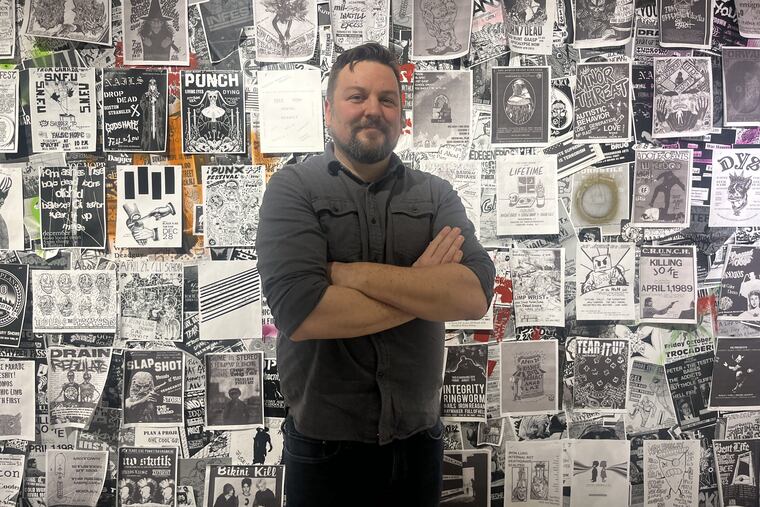Punk and disruption get the art gallery treatment at Stockton University
The exhibit’s centerpiece is a collage of more than 1,000 fliers advertising past punk music shows in Philly and South Jersey.

GALLOWAY, N.J. — Can you tame punk so it fits into an art gallery?
At Stockton University, curators Ryann Casey and Justin Gray, both in their 40s and veterans of the Philadelphia and South Jersey punk scenes, are making the case for it.
“It’s a history of energy” is how Gray describes the exhibit, called “Shortest, Fastest, Loudest,” a play on Shorter, Faster, Louder, the name of a Philly punk band Kid Dynamite album. The exhibit runs through April 6 at Stockton’s Galloway campus.
It is being paired with an exhibit in Stockton’s lower gallery featuring the work of Lebanon-born photographer and installation artist Ara Oshagan titled “Disrupted, Borders,” focusing on the history of the Armenian people, genocide, dislocation, and exile. The shows share common themes, Casey said.
“In the punk exhibition, we show the impact punk had on local communities and specifically artists but also discuss how the genre has embraced protest, antifascism, and community collaboration,” Casey said. “In similar ways, Ara Oshagan’s work discusses community across a broad spectrum of history and discusses the disruption of dislocation and marginalization.
“Diasporic identity and community representation are key elements in the work and connect to the punk ethos of community care and DIY ethics,” she said.
The cocurators work at Stockton University: Casey as an adjunct professor of photography, art history, and critical theory and the art gallery’s exhibition coordinator, Gray as a studio liaison. They met in the Philly punk scene two decades ago.
The centerpiece of the punk exhibit, in the upper gallery, is the flier wall, featuring more than 1,000 advertisements for punk shows in Philly and New Jersey stapled to a wall, flapping at the bottom, an immersive collage that tells the history of punk and punk art, show by show.
There’s the “Big Boys and Drug Puppies”flier with a cartoon of a skateboarder from an Asbury Park show. Another features a man putting a knife through his head, for a show at the Shore House in West Philly featuring Look Back and Laugh, and Fighting Dogs.
The fliers encompass “every form of creative visual art,” according to the exhibit. “The depth and variety of designs made, photocopied and stuck to a venue wall, plywood window cover or telephone pole is nearly limitless.”
Almost none of them were signed, dated, or credited. The curators decided to keep them all in black and white, true to their original ethos.
“When we were doing shows, it was, ‘What was the cheapest way to photocopy this and get this out?’“ says Casey. “Not great quality, but it does what it needs to do.”
There are fliers, sculpture, a button wall, album illustration, street art, poster art, zines, and photography by Philadelphia punk photographer Karen Kirchhoff documenting the spaces, like Disgraceland, that have hosted these shows over the years.
There’s also an unamplified record player where people can play vinyl records like Soul Glo’s Songs to Yeet at the Sun (assuming the needle isn’t broken.)
Low Level, a street artist in Philadelphia, stenciled punk lyrics onto vintage suitcases.
Gray said students have been intrigued to see an exhibit that feels “exciting and new,” one that connects them to an older generation.
“I keep putting fliers out for it, and they keep disappearing,” Gray said.
Casey is not unaware of some problematic aspects of the punk scene, which she experienced being a woman and a photographer, but she wants the exhibit to stress the unifying aspects of the scene and ability of the music and the community to serve as a rallying call.
However, Casey said she and Gray were conscious of not making the exhibit an exercise in nostalgia.
“We’re both old punks at this point,” she said. “We were thoughtful about the ideas, that we cannot just put in the ones that are our favorites in that time period. We wanted to be able to show that punk is alive and well. It evolves and it changes.”
“I think for me, if there was an ethos, it’s community, engagement, the political aspect, that you have a song that feels like a rallying call,” she said.
Both “Shortest, Fastest, Loudest: The Art of South Jersey & Philadelphia Punk” and “Ara Oshagan: Disrupted, Borders “ run through April 6. For programming, which includes a stencil and zine workshop on Feb. 15 and an artist panel on March 7, visit stockton.edu/art-gallery.